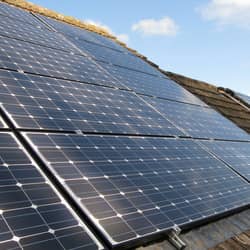 The March 11 earthquake and subsequent tsunami that struck Japan and damaged multiple nuclear reactors – leading to a potential nuclear catastrophe – has re-emphasized the risks posed by nuclear energy. This skittishness is translating into stronger expectations for solar energy and other forms of renewable energy this year and over the long term.
The March 11 earthquake and subsequent tsunami that struck Japan and damaged multiple nuclear reactors – leading to a potential nuclear catastrophe – has re-emphasized the risks posed by nuclear energy. This skittishness is translating into stronger expectations for solar energy and other forms of renewable energy this year and over the long term.
‘There is no silver lining in this horrific situation,’ writes Charles Annis, vice president of manufacturing research at DisplaySearch, in a recent blog post. ‘But Japan's disaster may become an important point in the debate on the true cost of various electricity-generating technologies. It may help swing the pendulum further away from nuclear and more towards solar and other renewables.’
Indeed, the situation has led to immediate performance gains for solar stocks. Adam Bergman, director of cleantech investment banking at Deutsche Bank Securities, tells Solar Industry that German solar stocks have fared particularly well in the wake of the disaster.
‘My expectation is that there will be more scrutiny on nuclear power plants in the U.S. and Europe, construction of new plants will likely be placed on hold, and current plants – especially in Germany – will be closed on their current schedule rather than [having their facility life extended],’ Bergman says.
Even China, whose reliance on nuclear energy was seen as necessary for the country to continue to meet its sizeable growth needs, suspended approval of 28 planned nuclear plants on Wednesday, according to a New York Times report. The announcement followed Chinese Premier Wen Jiabo's conversation with top-level advisors regarding Japan's ongoing nuclear emergency.
Bergman predicts that despite any short-term pause, China will nevertheless forge ahead with nuclear power plans over the long term. Due to the inherent limitations of coal, natural gas and renewables, nuclear remains the only viable solution for China's long-term energy needs, he says.
Other national governments with funds previously slated for nuclear plants could reallocate that money for solar power plant development. This shift would create incremental global demand for solar this year, according to a research noted posted by Jesse Pichel, Min Xu, Elaine Kwei and Constance Wang of Jefferies & Co.
Meanwhile, the PV industry is also assessing possible solar supply-chain risks stemming from disaster damage and production stoppages at Japanese factories that provide PV materials, especially solar silicon.
Among Japan's three largest polysilicon producers – Tokuyama, Mitsubishi and M. Setek – only M. Setek, owned by AUO, has sustained major disaster damage, according to Annis' post. The company has suspended production at its factory, which is located in hard-hit Soma Fukushima.
Annis points out that the ‘entire Japanese economy will be limping along for a while, which may cause some minor shipment and short-term pricing issues for PV components.’ Global supply-chain impact, however, is expected to be limited, as Japan accounts for less than 10% of total polysilicon, wafer and cell production capacity.
San Jose, Calif.-based module manufacturer SunPower echoed this assessment in a recent announcement, noting that less than 10% of its polysilicon is sourced from Japanese suppliers. The company added that although some of its supply-chain partners are experiencing production disruptions, none has sustained major facility damage, and alternate sources of polysilicon are available to replace any lost supply.
Overall, Japan-based firms such as Kyocera, Sanyo and Mitsubishi dominate the country's PV market, and foreign companies have little economic exposure, according to Jefferies' research note.
‘Japanese solar companies' market share outside of Japan is greater than Western/Chinese companies' market share in Japan,’ the note explains. ‘Thus, we believe Western/Chinese solar companies such as Yingli can grow share at the expense of Japanese players affected by the disaster.’
Photo: Sanyo solar modules. Credit: julian b via Flickr (CC license)

